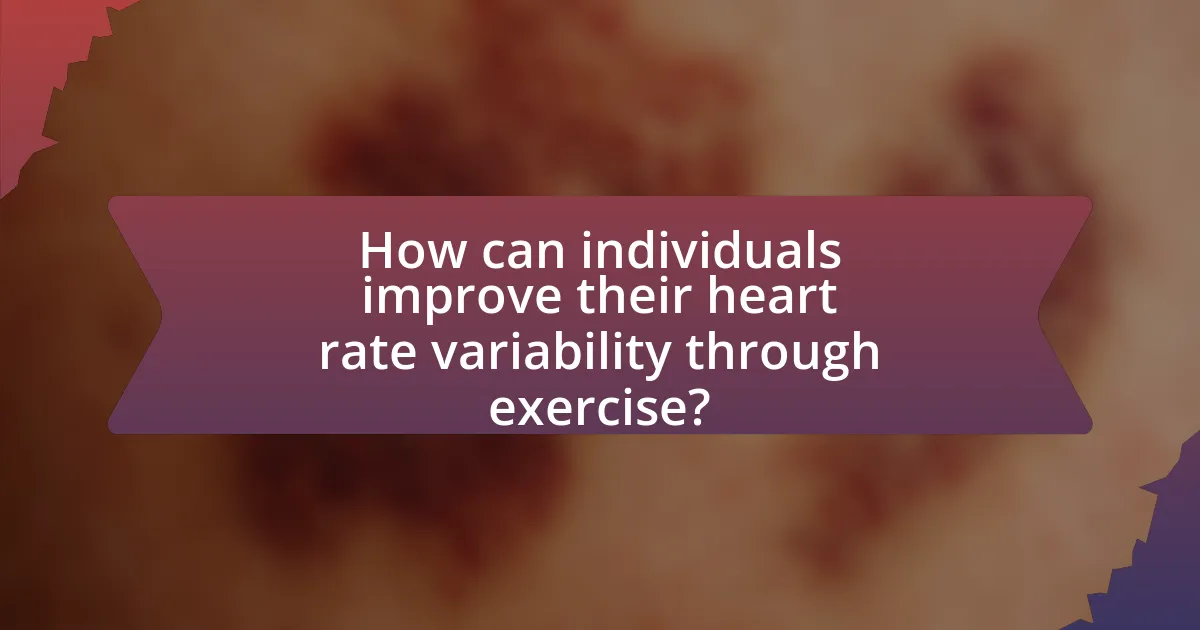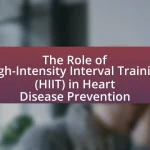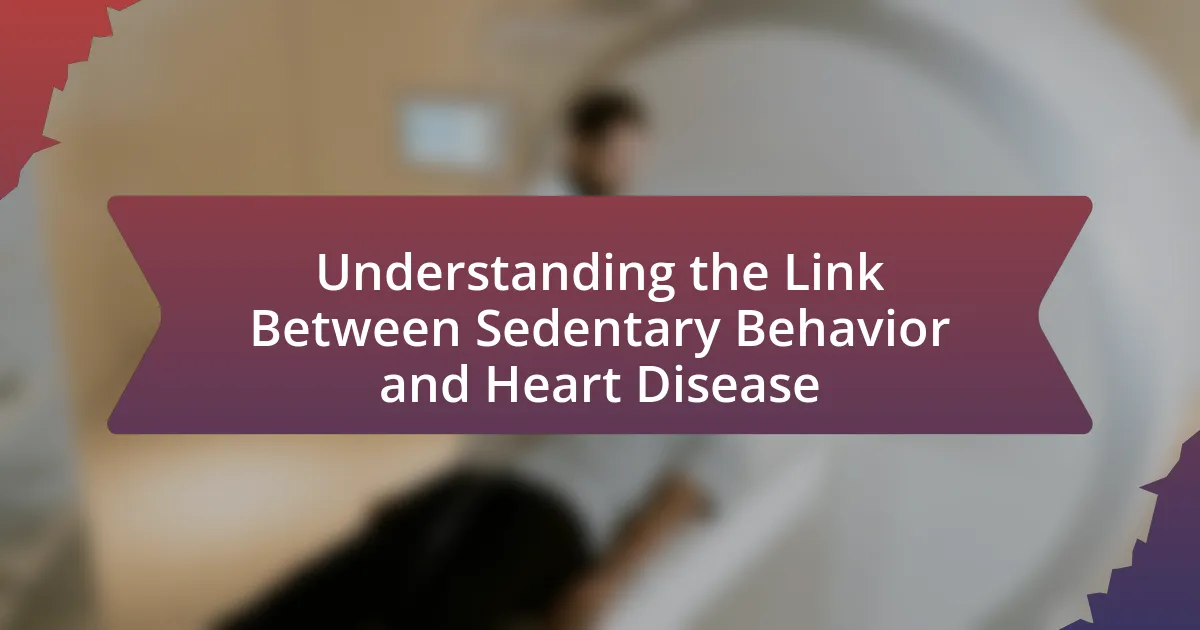The article explores the relationship between exercise and heart rate variability (HRV), highlighting how regular physical activity enhances HRV, indicating improved autonomic nervous system function and cardiovascular health. It discusses the physiological changes during exercise that affect HRV, the impact of different exercise types, and the significance of HRV as a health marker. Additionally, the article examines factors influencing HRV, including age, fitness level, gender, hydration, and environmental conditions, while providing practical tips for individuals to monitor and enhance their HRV through exercise and lifestyle adjustments.

What is the relationship between exercise and heart rate variability?
Exercise positively influences heart rate variability (HRV), indicating better autonomic nervous system function and cardiovascular health. Regular physical activity enhances HRV by promoting parasympathetic nervous system activity, which is responsible for relaxation and recovery. Studies show that individuals who engage in consistent aerobic exercise exhibit higher HRV compared to sedentary individuals, reflecting improved heart health and resilience to stress. For instance, a study published in the Journal of Sports Sciences found that moderate-intensity exercise significantly increases HRV, demonstrating the beneficial effects of physical activity on heart function and overall well-being.
How does exercise influence heart rate variability?
Exercise positively influences heart rate variability (HRV) by enhancing autonomic nervous system function and promoting cardiovascular health. Regular physical activity increases parasympathetic activity, which is associated with higher HRV, indicating better heart health and resilience to stress. Studies, such as one published in the Journal of Clinical Psychology, demonstrate that individuals engaging in consistent aerobic exercise show significant improvements in HRV compared to sedentary individuals. This improvement is linked to reduced sympathetic nervous system dominance and increased vagal tone, both of which are crucial for maintaining a balanced autonomic response.
What physiological changes occur during exercise that affect heart rate variability?
During exercise, physiological changes such as increased sympathetic nervous system activity and elevated levels of circulating catecholamines significantly affect heart rate variability. The sympathetic nervous system stimulates the heart to beat faster and with less variability, while catecholamines like adrenaline enhance heart rate and contractility, leading to a more uniform heart rhythm. Research indicates that during intense physical activity, heart rate variability decreases due to these factors, reflecting a shift towards a sympathetic dominance in autonomic regulation. This response is crucial for meeting the metabolic demands of exercise, as evidenced by studies showing that heart rate variability can serve as a marker for cardiovascular fitness and autonomic function during physical exertion.
How do different types of exercise impact heart rate variability differently?
Different types of exercise impact heart rate variability (HRV) in distinct ways, primarily due to their varying intensities and physiological demands. Aerobic exercises, such as running or cycling, typically enhance HRV by promoting parasympathetic nervous system activity, which is associated with relaxation and recovery. In contrast, high-intensity interval training (HIIT) can lead to temporary reductions in HRV immediately post-exercise due to increased sympathetic nervous system activation, but may improve overall HRV with consistent training over time. Resistance training also influences HRV, often resulting in lower HRV during the workout but potentially leading to improved HRV with regular practice as the body adapts. Studies, such as those published in the Journal of Sports Sciences, indicate that consistent aerobic training is linked to higher baseline HRV, while HIIT and resistance training can enhance HRV over longer periods through improved cardiovascular fitness and autonomic regulation.
Why is heart rate variability important for health?
Heart rate variability (HRV) is important for health because it reflects the autonomic nervous system’s regulation of the heart, indicating overall cardiovascular and emotional well-being. Higher HRV is associated with better stress resilience, improved recovery from exercise, and lower risk of cardiovascular diseases. Studies have shown that individuals with higher HRV tend to have better health outcomes, including lower rates of anxiety and depression, as well as enhanced physical performance. For instance, research published in the Journal of the American College of Cardiology found that low HRV is a predictor of increased mortality in patients with heart disease, underscoring its significance in health assessments.
What does heart rate variability indicate about the autonomic nervous system?
Heart rate variability (HRV) indicates the balance and functioning of the autonomic nervous system (ANS), specifically the interplay between the sympathetic and parasympathetic branches. A higher HRV reflects a dominant parasympathetic activity, suggesting better adaptability and resilience to stress, while a lower HRV indicates increased sympathetic activity, often associated with stress and reduced recovery capacity. Research shows that individuals with higher HRV tend to have better cardiovascular health and lower levels of anxiety, supporting the notion that HRV is a reliable marker of autonomic regulation and overall well-being.
How can heart rate variability be a marker for overall health and fitness?
Heart rate variability (HRV) serves as a marker for overall health and fitness by reflecting the autonomic nervous system’s regulation of heart function. A higher HRV indicates a well-functioning autonomic nervous system, which is associated with better cardiovascular health, improved stress resilience, and enhanced recovery from exercise. Studies have shown that individuals with higher HRV tend to have lower risks of cardiovascular diseases and better overall physical performance. For instance, research published in the Journal of the American College of Cardiology found that lower HRV is linked to increased mortality risk, highlighting its significance as a health indicator.

What factors affect heart rate variability during exercise?
Heart rate variability during exercise is primarily affected by factors such as exercise intensity, duration, individual fitness level, and autonomic nervous system balance. Higher exercise intensity typically leads to reduced heart rate variability due to increased sympathetic nervous system activity, while lower intensity can enhance variability as the parasympathetic system is more active. Additionally, longer exercise durations can lead to fatigue, which may decrease heart rate variability. Individual fitness levels also play a crucial role; well-trained athletes often exhibit higher heart rate variability compared to sedentary individuals, indicating better autonomic regulation. Studies have shown that these factors collectively influence heart rate variability, reflecting the body’s adaptive responses to physical stress.
How do age and fitness level influence heart rate variability?
Age and fitness level significantly influence heart rate variability (HRV), with younger individuals and those with higher fitness levels typically exhibiting greater HRV. Research indicates that HRV tends to decrease with age due to changes in autonomic nervous system function and cardiovascular health. For instance, a study published in the Journal of the American College of Cardiology found that older adults have lower HRV compared to younger adults, reflecting reduced parasympathetic activity. Additionally, individuals with higher fitness levels demonstrate enhanced HRV, as regular aerobic exercise promotes autonomic balance and improves cardiovascular efficiency. A meta-analysis in the journal Sports Medicine highlighted that trained athletes have higher HRV compared to sedentary individuals, indicating a robust autonomic response to physical stress.
What role does gender play in heart rate variability responses to exercise?
Gender significantly influences heart rate variability (HRV) responses to exercise, with research indicating that women typically exhibit higher baseline HRV compared to men. This difference is attributed to hormonal variations, particularly estrogen, which has been shown to enhance autonomic regulation and improve HRV. Studies, such as those published in the Journal of Applied Physiology, demonstrate that women often experience a more pronounced increase in HRV during recovery from exercise, suggesting a more efficient parasympathetic response. Additionally, men may show greater sympathetic activation during intense exercise, leading to lower HRV. These findings underscore the importance of considering gender when evaluating HRV as a marker of cardiovascular health and exercise response.
How does hydration status impact heart rate variability during physical activity?
Hydration status significantly impacts heart rate variability (HRV) during physical activity. Adequate hydration enhances cardiovascular function, allowing for better autonomic regulation, which is reflected in increased HRV. Conversely, dehydration can lead to reduced blood volume, increased heart rate, and diminished HRV, indicating impaired autonomic control. Research has shown that even mild dehydration can negatively affect HRV, as evidenced by a study published in the Journal of Applied Physiology, which found that dehydration reduced HRV during exercise, highlighting the importance of maintaining optimal hydration for cardiovascular health and performance.
What external factors can influence heart rate variability during exercise?
External factors that can influence heart rate variability during exercise include environmental conditions, hydration status, and psychological stress. Environmental conditions such as temperature and humidity can affect cardiovascular responses, with higher temperatures often leading to increased heart rates and reduced variability. Hydration status is critical, as dehydration can impair autonomic function and decrease heart rate variability. Psychological stress, including anxiety and mental fatigue, can also negatively impact heart rate variability by altering autonomic nervous system balance. Studies have shown that these factors can significantly affect heart rate dynamics, highlighting the importance of considering them during exercise assessments.
How do environmental conditions affect heart rate variability during workouts?
Environmental conditions significantly influence heart rate variability (HRV) during workouts by affecting the body’s autonomic nervous system response. For instance, high temperatures can lead to increased sympathetic nervous system activity, resulting in lower HRV, while cooler environments may promote higher HRV due to reduced stress on the cardiovascular system. Research indicates that exercising in hot and humid conditions can elevate heart rates and decrease HRV, as shown in a study published in the Journal of Sports Sciences, which found that athletes experienced a marked reduction in HRV when training in extreme heat compared to temperate conditions. This demonstrates that environmental factors such as temperature and humidity directly impact the physiological responses during exercise, thereby altering HRV.
What is the impact of stress on heart rate variability during exercise?
Stress negatively impacts heart rate variability (HRV) during exercise by reducing the body’s ability to adapt to physical demands. When an individual experiences stress, the autonomic nervous system shifts towards sympathetic dominance, which is associated with the “fight or flight” response. This shift leads to decreased HRV, indicating reduced parasympathetic activity and impaired recovery. Research has shown that higher stress levels correlate with lower HRV, particularly during physical exertion, as evidenced by a study published in the Journal of Sports Sciences, which found that athletes under psychological stress exhibited significantly lower HRV compared to their baseline measurements during exercise.

How can individuals improve their heart rate variability through exercise?
Individuals can improve their heart rate variability (HRV) through regular aerobic exercise, strength training, and flexibility exercises. Engaging in aerobic activities like running, cycling, or swimming enhances cardiovascular fitness, which is linked to increased HRV. Research indicates that consistent aerobic exercise can lead to a 10-20% improvement in HRV over time. Strength training also contributes positively by reducing stress and improving overall body function, while flexibility exercises, such as yoga, promote relaxation and further enhance HRV. Studies show that individuals who incorporate these forms of exercise into their routines experience better autonomic nervous system balance, which is crucial for higher HRV.
What types of exercise are most effective for enhancing heart rate variability?
Aerobic exercises, such as running, cycling, and swimming, are most effective for enhancing heart rate variability. These activities promote cardiovascular fitness and stimulate the autonomic nervous system, leading to improved heart rate variability. Research indicates that consistent aerobic exercise can increase heart rate variability by enhancing parasympathetic activity, which is associated with relaxation and recovery. A study published in the Journal of Clinical Psychology found that individuals engaging in regular aerobic exercise exhibited significantly higher heart rate variability compared to sedentary individuals, demonstrating the positive impact of such exercises on autonomic regulation.
How does incorporating mindfulness and breathing techniques improve heart rate variability?
Incorporating mindfulness and breathing techniques improves heart rate variability (HRV) by enhancing autonomic nervous system regulation. Mindfulness practices, such as meditation and focused breathing, activate the parasympathetic nervous system, which promotes relaxation and reduces stress responses. Research indicates that individuals who engage in mindfulness and controlled breathing exhibit increased HRV, reflecting a healthier balance between sympathetic and parasympathetic activity. A study published in the journal “Frontiers in Human Neuroscience” by Brown et al. (2013) found that participants practicing mindfulness showed significant improvements in HRV, demonstrating the physiological benefits of these techniques on heart health.
What role does recovery play in improving heart rate variability after exercise?
Recovery plays a crucial role in improving heart rate variability (HRV) after exercise by allowing the autonomic nervous system to restore balance between sympathetic and parasympathetic activity. During exercise, sympathetic activity increases, leading to a decrease in HRV; however, effective recovery promotes parasympathetic dominance, which enhances HRV. Research indicates that adequate recovery strategies, such as rest, hydration, and nutrition, can significantly elevate HRV levels, reflecting improved cardiovascular health and resilience. For instance, a study published in the Journal of Sports Sciences found that athletes who engaged in proper recovery techniques exhibited higher HRV compared to those who did not, underscoring the importance of recovery in optimizing heart rate variability post-exercise.
What practical tips can help individuals monitor and enhance their heart rate variability?
To monitor and enhance heart rate variability (HRV), individuals can utilize several practical tips. First, regular use of wearable devices, such as heart rate monitors or fitness trackers, allows for continuous tracking of HRV metrics, providing real-time data on autonomic nervous system function. Research indicates that consistent monitoring can help individuals identify patterns and make informed lifestyle adjustments (Kiviniemi et al., 2019, Journal of Sports Sciences).
Second, engaging in regular aerobic exercise, such as running or cycling, has been shown to improve HRV by enhancing cardiovascular fitness and promoting parasympathetic nervous system activity. A study by Buchheit (2014) in the Journal of Sports Medicine highlights that endurance training significantly increases HRV in athletes.
Third, incorporating stress management techniques, such as mindfulness meditation or deep breathing exercises, can positively influence HRV. A meta-analysis by Khalsa et al. (2015) in the Journal of Psychosomatic Research found that mindfulness practices lead to significant improvements in HRV, indicating better stress resilience.
Lastly, maintaining a balanced diet rich in omega-3 fatty acids, antioxidants, and hydration supports overall heart health and can enhance HRV. Research published in the American Journal of Clinical Nutrition (Bistrian et al., 2018) suggests that dietary choices directly impact cardiovascular function and HRV.
By implementing these strategies, individuals can effectively monitor and enhance their heart rate variability, leading to improved overall health and well-being.
How can wearable technology assist in tracking heart rate variability during exercise?
Wearable technology assists in tracking heart rate variability (HRV) during exercise by utilizing sensors that monitor heart rate and physiological responses in real-time. These devices, such as smartwatches and fitness trackers, employ photoplethysmography (PPG) and electrocardiogram (ECG) technologies to measure the time intervals between heartbeats, which is essential for calculating HRV. Research indicates that accurate HRV monitoring can provide insights into an individual’s autonomic nervous system function and recovery status, enhancing training effectiveness and overall health management. For instance, a study published in the Journal of Sports Sciences demonstrated that wearable devices could reliably track HRV changes during various exercise intensities, confirming their utility in optimizing athletic performance.
What are some best practices for incorporating heart rate variability training into a fitness routine?
To effectively incorporate heart rate variability (HRV) training into a fitness routine, individuals should prioritize consistent monitoring of their HRV levels, ideally using a reliable heart rate monitor or wearable device. This practice allows for the identification of baseline HRV and tracking changes over time, which is crucial for understanding personal recovery and stress levels.
Additionally, integrating HRV training should involve a combination of aerobic exercises, mindfulness practices such as meditation or yoga, and adequate rest periods. Research indicates that aerobic activities can enhance HRV by improving cardiovascular health, while mindfulness practices help reduce stress, which positively influences HRV.
Furthermore, it is essential to tailor the intensity and duration of workouts based on HRV readings; lower HRV may indicate a need for lighter training or recovery days, while higher HRV can signal readiness for more intense workouts. This adaptive approach is supported by studies showing that training based on HRV can lead to improved performance and reduced injury risk.





